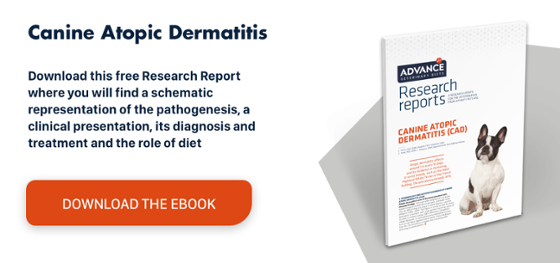Vasculitis in dogs: the skin as a target organ
Vasculitis in dogs is described as an aberrant immune reaction in cutaneous and/or systemic blood vessels, while its clinical presentation depends on the severity and extent of vascular destruction.1
Introduction
Cutaneous vasculitis should not be considered a definitive diagnosis, but rather a clinical presentation that may require further diagnostic effort to establish its aetiology and manage the case correctly.
Vasculitis in dogs can be triggered by various factors (Table 1), for instance, medications, infections, autoimmune diseases such as lupus erythematosus, and so on. Therefore, it is important to record a detailed clinical history that can be combined with the clinical and histopathological findings to make an accurate diagnosis.1
Vasculitis in dogs: aetiopathogenesis
Immunologically, immune-mediated vasculitis may be due to type I, II or III hypersensitivity reactions; however, type III reactions are thought to be the primary pathogenic mechanism in most cases of cutaneous vasculitis in dogs.1
On the other hand, from a histological perspective, there is a distinction between “true vasculitis” and “vascular disease”, as the latter refers to thromboembolic events and vascular occlusion caused by fibrin thrombi. “True vasculitis” is initially classified as either leukocytoclastic (histological evidence of nuclear pyknosis and karyorrhexis) or nonleukocytoclastic and then further grouped according to the predominant cell type as neutrophilic, eosinophilic or lymphocytic. Finally, ischaemic skin diseases are considered low cellularity vasculitis (cell-poor vasculitis). 1,2
Diagnosis
The diagnosis of cutaneous vasculitis is confirmed through a biopsy. The following should be performed whenever vasculitis is suspected:
- Complete anamnesis looking for exposure to triggers (Table 1).
- Blood and urine samples for haematology, blood chemistry, urinalysis and serology for vector-borne diseases (in endemic areas).
- Blood cultures in septic patients and coagulation tests where there is marked cutaneous bleeding.1 In these patients, a D-dimer concentration > 500 mg/mL suggests the presence or imminent onset of vascular thrombosis.3
If a triggering cause cannot be identified, vasculitis is considered idiopathic, but it is very important to have performed a complete differential diagnosis before reaching this conclusion.
Clinical picture
Cutaneous vasculitis can manifest with just skin lesions (purpura, scales, haemorrhagic bullae, hives, papules, oedema), but these are often preceded or accompanied by systemic signs (anorexia, weakness, discomfort, pain, pyrexia and less frequently joint disease, neuropathy, myopathy, glomerulonephritis, pericarditis or enteritis).
If the lesions are severe, then hypoxia or vascular ischaemia will lead to necrosis of the affected tissue that produces crateriform ulcers and scabs. The area may appear firm, discoloured and cold to the touch. Nodules may also appear if the subcutaneous adipose tissue is affected. The lesions can appear anywhere on the body and often follow a linear pattern that mirrors the vascular anatomy).1 Patients with ischaemic skin disorders generally have milder signs.2
Treatment
The treatment of vasculitis in dogs must be adapted to each particular case and based on the anamnesis and clinical signs, identification and control of the trigger, and the case’s particular progression or regression.
Proper care of lesions is essential in patients with severe ulcers to reduce the risk of infection and subsequent sepsis.
Glucocorticoids are indicated because of the process’ immune-mediated character; however, in the absence of an accurate aetiological diagnosis, the potential for negative effects of immunosuppression in patients with an active infection and poor wound healing should be taken into account. Therefore, corticosteroid therapy should begin with prednisone/prednisolone at 0.5–1 mg/kg/24 hours, before increasing the dose, if necessary.1
There is anecdotal evidence of cyclosporine use in some types of vasculitis, but recommendations are to reserve it for corticosteroid-intolerant, idiopathic cases that require long-term medical management.1
Azathioprine can be used to reduce the dose and side effects of corticosteroids, but bear in mind that it can take 1–6 weeks before it starts working and it can produce some significant side effects, especially in the blood and liver.1
Pentoxifylline is a methylxanthine with an excellent safety profile that has been recommended to treat cutaneous vasculitis thanks to its haemorrheologic and immunomodulatory effects. It is the drug of choice (combined with vitamin E) in the treatment of ischaemic skin disorders2, while it is mainly used as a corticosteroid-sparing agent to treat “true vasculitis”. It has a very slow mechanism of action and may take weeks or months before it produces a clinical response.1,2
A tetracycline combined with niacinamide can be used in mild cases. The combination is usually well tolerated, but gastrointestinal and hepatic side effects have been reported, generally related to niacinamide.1
Conclusions
Cutaneous vasculitis is an inflammatory process that damages the blood vessels and may be caused by a variety of triggers. As such, it should not be considered a final diagnosis. A detailed study is required to identify and correct the trigger, adapting the treatment to each individual case.


